The Crowded Table: Fall 2012 Edition
Hello, dear readers, and welcome to another installment of The Crowded Table. Despite all the work that’s been piling up here at Dice Hate Me HQ, we’ve been able to squeeze in a surprising amount of gaming, including one weekend visit by Compounded designer Darrell Louder in which we fit in 23 different titles, all while working on some game design. We didn’t sleep much, but it was worth it. Below you’ll find four games that have graced our table in the past few weeks, a couple of which you’ll probably see pop up again on Dice Hate Me before too long. Enjoy!
Star Wars: X-Wing Miniatures Game
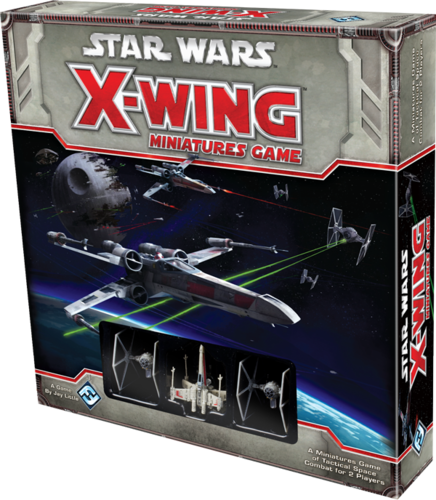 There were a lot of overly-hyped new releases from game companies at GenCon this year, but no company had their hype machine humming quite as well as Fantasy Flight Games. While Netrunner had the honor of being the belle of the ball – selling out in about 15 minutes on opening day – X-Wing was the prize thoroughbred most had their money on before the big show. For this old miniatures wargamer, I’m not sure why it didn’t really grab my attention; maybe it was Star Wars burnout, or the thought of paying over $10 for a single miniature, or maybe it was just that Netrunner was too enticing. But now that I’ve actually played X-Wing I can safely say that FFG certainly has my attention now. And, soon, they’ll probably have a little bit more of my money, too.
There were a lot of overly-hyped new releases from game companies at GenCon this year, but no company had their hype machine humming quite as well as Fantasy Flight Games. While Netrunner had the honor of being the belle of the ball – selling out in about 15 minutes on opening day – X-Wing was the prize thoroughbred most had their money on before the big show. For this old miniatures wargamer, I’m not sure why it didn’t really grab my attention; maybe it was Star Wars burnout, or the thought of paying over $10 for a single miniature, or maybe it was just that Netrunner was too enticing. But now that I’ve actually played X-Wing I can safely say that FFG certainly has my attention now. And, soon, they’ll probably have a little bit more of my money, too.
In X-Wing, Fantasy Flight has distilled the essence of miniatures wargaming magnificently, providing a system of movement orders and tactical operations that is a breeze to grasp and put into practice. Issuing movement orders is done secretly and simultaneously and then revealed according to pilot initiative. This provides a solid simulation of dogfighting where you do your best to anticipate your opponent’s maneuvers. And gone are the old school rulers typically used to gauge movement distances in a minis game; instead, FFG provides punchboard templates that are placed at the front of the miniature’s base, just inside handy notches. FFG has also done a great job of providing customization and replayability, with an intuitive system of pilot, weapon and gadget upgrade cards that can be mixed and matched to a certain fleet “build point” total.
Overall, it’s a very satisfying system that breaths new life into what I often consider of late to be an underwhelming and over-saturated universe. And Steve Jackson Games, I hope you’re paying attention – The X-Wing system is very much what the new Car Wars should aspire to and surpass. I’ve got my finger on that particular money trigger – and it’s getting itchy.
Viticulture
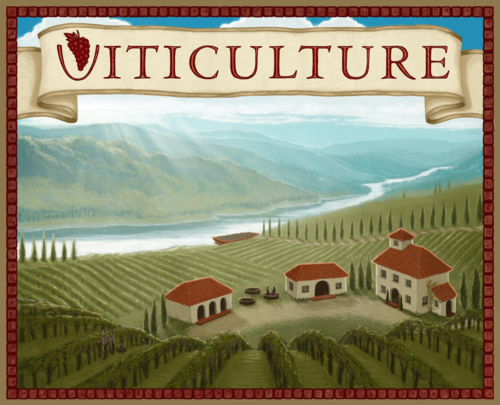 As you dear readers may have noticed, we get sent a lot of Kickstarter games for review. Some are satisfying gems, a little rough around the edges, but overall a welcome addition to the hobby. Others – well, not so much. So, when Jamey Stegmaier asked us if we’d like to take a look at Viticulture we were a little bit apprehensive. You see, we love both wine and worker placement, so could a game that incorporated the two live up to expectations? In the end, we shouldn’t have worried – Viticulture delivered, and then some.
As you dear readers may have noticed, we get sent a lot of Kickstarter games for review. Some are satisfying gems, a little rough around the edges, but overall a welcome addition to the hobby. Others – well, not so much. So, when Jamey Stegmaier asked us if we’d like to take a look at Viticulture we were a little bit apprehensive. You see, we love both wine and worker placement, so could a game that incorporated the two live up to expectations? In the end, we shouldn’t have worried – Viticulture delivered, and then some.
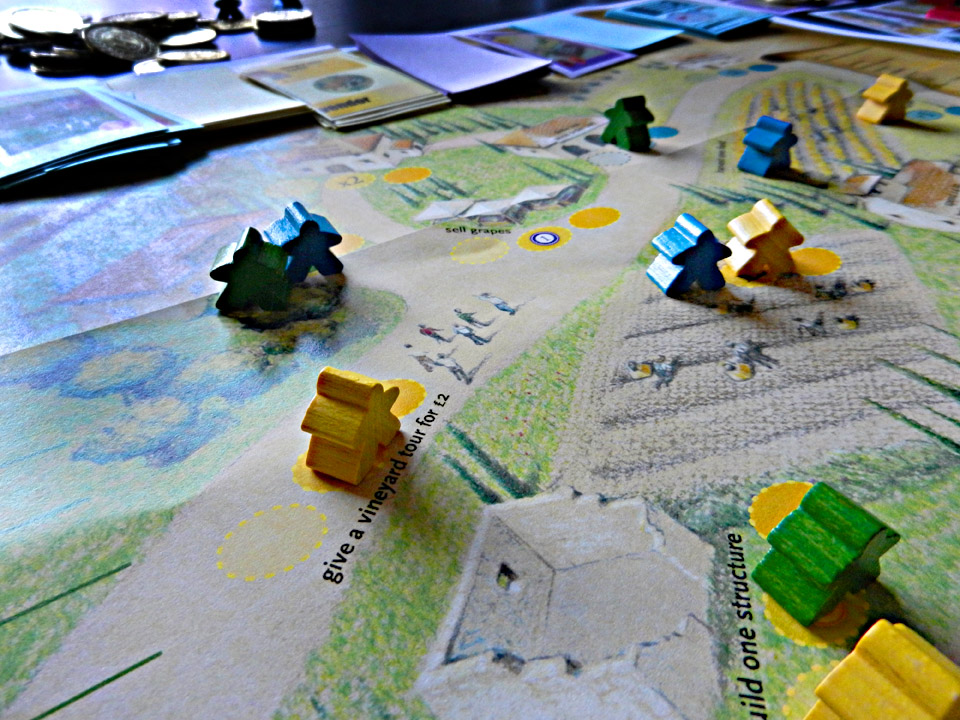 Some may say that worker placement is an overdone mechanic. I would humbly disagree, and Viticulture brings a solid and fresh take on this classic system. The great thing about worker placement is that it’s intuitive and often provides a load of interesting choices, especially when placement locations are limited. Viticulture captures that essence admirably, ratchets the limitations down almost to a dangerous degree, and couples the placement decisions with how best to manage your personal vineyard. Everyone has access to vines, and can build the requisite resource engine to harvest grapes, make wine and sell that wine for victory points. However, Viticulture also provides a healthy array of other ways to win, including selling the uncrushed grapes at market and outfitting the vineyard with a tasting room to maximize those winery tours. At times, players may find themselves spending a lot more time showing off their vineyards than making wine, but truth be told, I have a feeling a lot of wineries have operated the same way over the years.
Some may say that worker placement is an overdone mechanic. I would humbly disagree, and Viticulture brings a solid and fresh take on this classic system. The great thing about worker placement is that it’s intuitive and often provides a load of interesting choices, especially when placement locations are limited. Viticulture captures that essence admirably, ratchets the limitations down almost to a dangerous degree, and couples the placement decisions with how best to manage your personal vineyard. Everyone has access to vines, and can build the requisite resource engine to harvest grapes, make wine and sell that wine for victory points. However, Viticulture also provides a healthy array of other ways to win, including selling the uncrushed grapes at market and outfitting the vineyard with a tasting room to maximize those winery tours. At times, players may find themselves spending a lot more time showing off their vineyards than making wine, but truth be told, I have a feeling a lot of wineries have operated the same way over the years.
Four card stacks that provide vines, tourists that grant special boons, and a market for wine buyers adds a plethora of variety, a lot of fun and a bit of luck. Interestingly, those same card stacks that bring a lot of joy to the game could also be a drawback for some hardcore Eurogamers who like information of the un-hidden variety. Still, for fans of games like Stone Age, Viticulture has the grapes to be a full glass of very satisfying gaming.
Viticulture is available on Kickstarter, but hurry – there are only a few days left to get tipsy!
Jungle Ascent
 Every couple of months or so I’ll get an email out of the blue from Phil Kilcrease, the founder of 5th Street Games. “Hey, guess what? We’re Kickstarting another game,” he says. “Wanna try it out?” My first inclination is always to tell him to slow down and leave some for the rest of us, but my second inclination is always to tell him absolutely yes, I want to try out that game. Thankfully, I’m rarely disappointed.
Every couple of months or so I’ll get an email out of the blue from Phil Kilcrease, the founder of 5th Street Games. “Hey, guess what? We’re Kickstarting another game,” he says. “Wanna try it out?” My first inclination is always to tell him to slow down and leave some for the rest of us, but my second inclination is always to tell him absolutely yes, I want to try out that game. Thankfully, I’m rarely disappointed.
 Jungle Ascent is a perfect addition to Phil’s lineup, which includes titles like Farmageddon, Castle Dash and My Happy Farm – games which are extremely easy to pick up, play and share with family and casual gamers. The game itself was created to emulate a 2D platformer, and indeed it does, both in theme and in execution. The goal in the game is to navigate your whimsical explorer up a cliff to boundless riches lying above. You accomplish this by playing various types of cards – ladders and bridges that help you climb, hazards such as crushing logs and updraft fireballs that hamper the other players, and effects and interrupts that give you certain abilities such as moving faster, taking more actions or drawing more cards.
Jungle Ascent is a perfect addition to Phil’s lineup, which includes titles like Farmageddon, Castle Dash and My Happy Farm – games which are extremely easy to pick up, play and share with family and casual gamers. The game itself was created to emulate a 2D platformer, and indeed it does, both in theme and in execution. The goal in the game is to navigate your whimsical explorer up a cliff to boundless riches lying above. You accomplish this by playing various types of cards – ladders and bridges that help you climb, hazards such as crushing logs and updraft fireballs that hamper the other players, and effects and interrupts that give you certain abilities such as moving faster, taking more actions or drawing more cards.
If some of the game’s aspects sound vaguely familiar there may be good reason – it has a retro sensibility with straightforward mechanisms that aren’t terribly revolutionary and often harken back to a bygone boardgaming age. However, all that said, the age it emulates is incredibly charming – and so is Jungle Ascent. The game plays fast and, even though some cards may make you furious, there’s plenty of punk factor to spread around. And the wonderful, whimsical art creates an atmosphere that’s relaxed and welcoming to most any gamer, particularly the younger explorers.
You can discover the riches of Jungle Ascent on Kickstarter, but there’s precious little time left to scramble up that cliff.
Rumble in the House
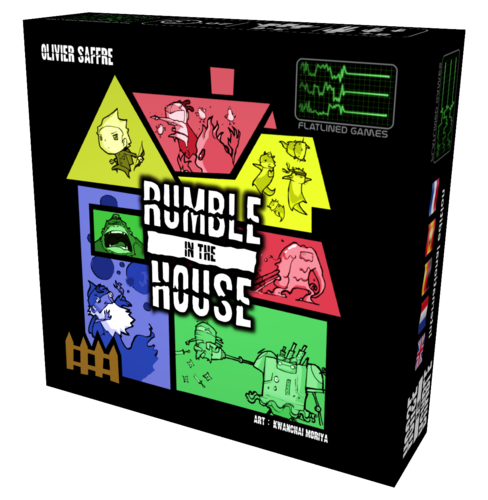 I’m just going to come right out and say it: Some of you are going to hate Rumble in the House. I’m sorry, but it’s unavoidable. I can even hear some of the specific comments: “Well, that was pretty stupid.” “What did we just play?” “How is this a game?” The reason I can hear those comments is because we made those very same comments during our first play of Rumble in the House. The fascinating part of that first play, however, is the wide-eyed stupor with which we uttered those comments, and the fact that we simply couldn’t stop laughing. Rumble in the House – despite being undefinably, undeniably, unbelievably goofy – is surprisingly fun. And, honestly, for the first time in all my gaming experiences, I can’t precisely put my finger on the how and why.
I’m just going to come right out and say it: Some of you are going to hate Rumble in the House. I’m sorry, but it’s unavoidable. I can even hear some of the specific comments: “Well, that was pretty stupid.” “What did we just play?” “How is this a game?” The reason I can hear those comments is because we made those very same comments during our first play of Rumble in the House. The fascinating part of that first play, however, is the wide-eyed stupor with which we uttered those comments, and the fact that we simply couldn’t stop laughing. Rumble in the House – despite being undefinably, undeniably, unbelievably goofy – is surprisingly fun. And, honestly, for the first time in all my gaming experiences, I can’t precisely put my finger on the how and why.
Here are the rules: On your turn you take one action – either move a character that is alone in a room in the house to an adjacent room, or choose a room filled with multiple characters to start a “rumble” in which you simply remove one of the characters. Each player is randomly assigned two characters, which they try to keep secret during the game. The goal is to keep their characters in the house as long as possible. The last character standing gets a ton of points, and then points are assigned on down the line according to when the character lost a rumble. And that’s it, that’s the whole game. To say that one has to play in the “spirit of the game” here would be an understatement, but it’s the quirk and inexplicable charm that helps to keep the fun on rails.
Truth be told, I think some of the fun might have something to do with a cat with a machine gun taking out Cthulhu. Or a penguin with dynamite threatening a pink ninja and a guy in a chicken costume. Or the fact that all these strange dudes, animals and creatures all live in a 12-room frat house that has pizza in the corner, a swank pool table and bones in the dungeon-like basement. The fun might lie in Kwanchai Moriya’s always awesome, engaging and offbeat art. Overall though, I think the fun comes from a game that simply and unabashedly creates a wild world with little constraints and lets the players bring their own brand of crazy to the house party.
For more discussion of Viticulture, Jungle Ascent and Rumble in the House, check out Episode 36 of The State of Games.
Related posts:
- The Crowded Table – Summer 2012 Pre-GenCon Edition
- The Crowded Table – Spring 2012 Edition
- The Crowded Table: April/May Edition
- The Crowded Table: Autumn 2011 Edition
- Origins 2012 Photo Recap – A Publisher’s Perspective

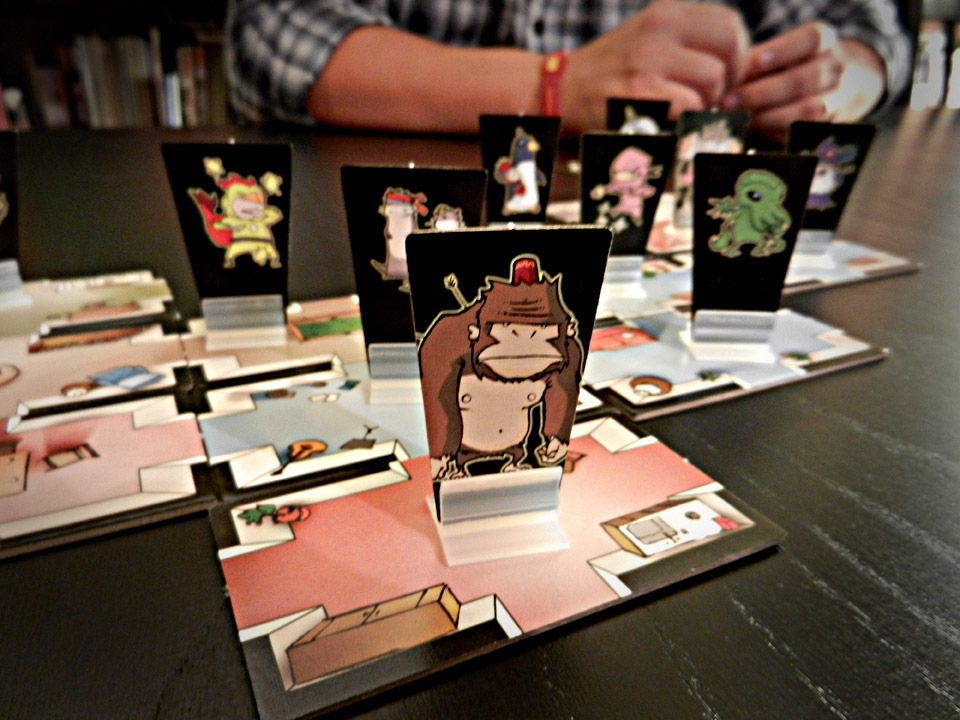
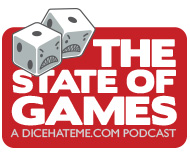

One day I will try a minis game. Maybe it will be X-wing.